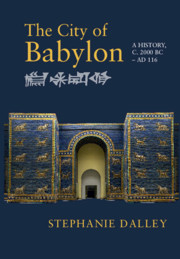Book contents
- The City of Babylon
- The City of Babylon
- Copyright page
- Contents
- Illustrations and Maps
- Preface
- Conventions
- Timeline
- Written Languages and Their Scripts
- 1 Land and Peoples
- 2 Discoveries and Excavations
- 3 First Kings to the End of the Great Rebellion, c. 1894–c. 1732
- 4 Law, Education, Literature, and the Path to Supremacy
- 5 From the Great Rebellion to the End of the First Dynasty, c. 1732–1592
- 6 The Next Six Centuries
- 7 In the Shadow of Assyria, 978–625
- 8 Empire
- 9 From the Death of Nebuchadnezzar II to the Death of Cambyses, 561–522
- 10 Darius I to Alexander, and Seleucid to Parthian Rule
- 11 First Parthian Conquest, 141 BC, to the Visit of Trajan in AD 116
- Appendix: Genesis 14:1–16 and Possible Links with Foreign Rulers Early in the Reign of Hammurabi
- Bibliography
- Index
1 - Land and Peoples
An Introduction
Published online by Cambridge University Press: 23 June 2021
- The City of Babylon
- The City of Babylon
- Copyright page
- Contents
- Illustrations and Maps
- Preface
- Conventions
- Timeline
- Written Languages and Their Scripts
- 1 Land and Peoples
- 2 Discoveries and Excavations
- 3 First Kings to the End of the Great Rebellion, c. 1894–c. 1732
- 4 Law, Education, Literature, and the Path to Supremacy
- 5 From the Great Rebellion to the End of the First Dynasty, c. 1732–1592
- 6 The Next Six Centuries
- 7 In the Shadow of Assyria, 978–625
- 8 Empire
- 9 From the Death of Nebuchadnezzar II to the Death of Cambyses, 561–522
- 10 Darius I to Alexander, and Seleucid to Parthian Rule
- 11 First Parthian Conquest, 141 BC, to the Visit of Trajan in AD 116
- Appendix: Genesis 14:1–16 and Possible Links with Foreign Rulers Early in the Reign of Hammurabi
- Bibliography
- Index
Summary
The setting of the city within the environment of Mesopotamia, on a branch of the river Euphrates, was without special advantages amid more ancient cities with older fame. Sumerian and Semitic Akkadian were very different languages integrated into the urbanized written culture, whereas Amorite immigrants from the west were tribal outsiders who often assimilated in the cities. Water management by canals, sluices, and flood control, and the extension of land for agriculture and settlement were duties of kings reflected in early myths. Merchants travelled abroad, west to the Mediterranean, north into Anatolia, east across the river Tigris into Iran, where they encountered the rival civilization of Elam, and south down the Arabian Gulf. They brought in precious metals, stones, timber, and plants. After 1,300 years, Babylon became a ceremonial centre without indigenous kings, but foreign kings still came to have their claim to rule legitimized in a city where the bearing of arms was prohibited. King-lists and chronicles underpinned Babylonians’ understanding of their own history; prayers, songs, epics, technical manuals, rituals, records of divination, and astronomy as well as archival and administrative texts were written on various media, of which only clay, being inorganic, survives. Temples, a palace, a harbour, city walls, and gates characterized urban space.
Keywords
- Type
- Chapter
- Information
- The City of BabylonA History, c. 2000 BC – AD 116, pp. 1 - 21Publisher: Cambridge University PressPrint publication year: 2021

